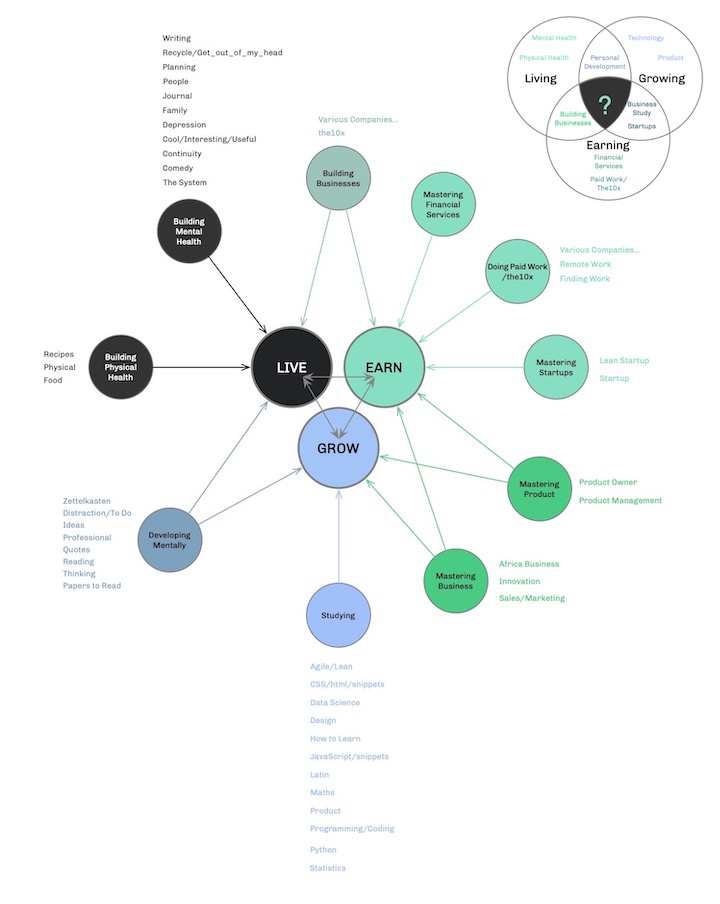Standing on one LEG and zettelkasten
12 Feb 2024tl;dr
My journey and some insights regarding organisation, systems, second brains, digital zettelkasten.
- Why?
- What?
- Who?
- How?
- Where to?
1. Why?
More than five years ago I started by collecting and sorting:
- What I spent my time/ energy on
- What I cared about and/or wanted to improve
- Digital stuff (books, links, articles etc.) I had accumulated
To give some idea of what that looked like:

I also created a framework, tech-stack and grand scheme for being able to plan and accurately time-track everything I spent time on (cue mild shivering and visions of the quantified self) — but that’s for another entry.
2. What?
What I got to was a sort of high level taxonomy (venn diagram) that covered everything via the categories of Living, Earning and Growing (LEG) and their intersections which broke down into 10 ‘goals’ and then 50 areas. (This evolved quite a bit - another, other entry).
This felt like progress since I could initially sort everything, cascade down the taxonomy to the right area and moving forward knew where to save things. (Note - I still had/have a ‘misc.’ category (cool_ interesting_ useful) which kind of feels like a cheat but seems to have-to exist to demonstrate the set of all things not in a set).
It looked like this:

The overlap or intersection dimension was interesting but before I got too far into trying to derive some weird version of Ikigai from first principles I realised that it lacked the ability to see in detail any meaningful connections between items and perhaps to generate new and interesting ideas or comparisons.
3. Who?
Enter stage links (left in german ( ͡° ͜ʖ ͡°) ) Niklas Luhmann - German sociologist, philosopher of social science, prominent thinker in systems theory and all round prolific writer. Over 30+ years he published 70 books and almost 400 articles - there are also over 150 unfinished manuscripts left in his estate — at least one of them is a text of 1000 pages. He was famous for his extensive use of the “slip box” or Zettelkasten note-taking method. He built up a zettelkasten (it can be seen digitised and translated via Google here) of some 90,000 index cards for his research, and credited it with making his extraordinarily prolific writing possible.
The chief hack was a numbering system and fixed addresses but zettelkasten is really the act of breaking your sources into concepts written in your own words and then linking those concepts into existing notes in a way that builds meaningful relationships between the ideas. This way, you should come to understand the concepts you’re learning and thinking about more deeply as well as building a persistent representation of that understanding.
This is obviously super useful for future writing and reading, or can just act as a set of notes which help thinking things through as you add more depth and context. This is why people sometimes call a zettelkasten an external brain.
Speaking of which, meet Vannevar Bush - visionary American engineer, inventor, science administrator, and policymaker known for pioneering early computing, leading wartime research, shaping postwar science policy and conceptualizing the memex - a hypothetical device described in “As We May Think”.
Envisioned as an analog computer to supplement human memory, the memex (a combination of “memory” and “index”) would store and automatically cross-reference all of the user’s books, records and other information. This cross-referencing, which Bush called associative indexing, would enable users to quickly and flexibly search huge amounts of information and more efficiently gain insights from it. The concept of the memex influenced the development of early hypertext systems, eventually leading to the creation of the World Wide Web, and personal knowledge base software.
4. How?
There’s already masses of material on the internet not to mention hours of productivity/life-hack/self-improvement porn on Youtube discussing ‘second-brains’, note-taking, zettelkasten and lots of different personal knowledge software. I won’t be adding to that here.
For just sorting my digital material I used a file/folder structure based on the above and for notes I ended up with Obsidian with an identical structure. (Note: not open source but free for personal use. Full disclosure - I paid a one off Catalyst license (Insider) to support development).
Into those I sorted the previously mentioned files, images, links, notes, books etc. Before I started improving/evolving it this year, the notes in Obsidian looked like this:

That’s supposedly a knowledge graph (one of Obsidian’s cutesy display features) which is indexed on tags and nested tags based on some of the above taxonomy. Whatever metadata, references or tags you choose to link notes, Obsidian can create a view of it - I won’t elaborate as although it shows some interesting connectivity and clustering thats about it. I guess it was more a proof of concept.
5. Where to?
I created a new vault (Obsidian speak for folder with notes, attachments and config) and am selectively copying across/processing content from the previous. This allows me to improve on a few things:
- Use more robust ‘zettel-y’ linking and note types (a particularly key part is the processing of ‘fleeting notes’ into ‘permanent’ and ‘literature’ notes) — in other words I reserve the right to keep dumping stuff into the old vault as I find it.
- Focus on how the whole drives goals and outcomes
- See concepts and relationships more clearly and (hopefully) build some useful understanding
- Select/create content for this site (there is a post on how that happens)
Videbimus (lat. We shall see…)
Thanks for your time.